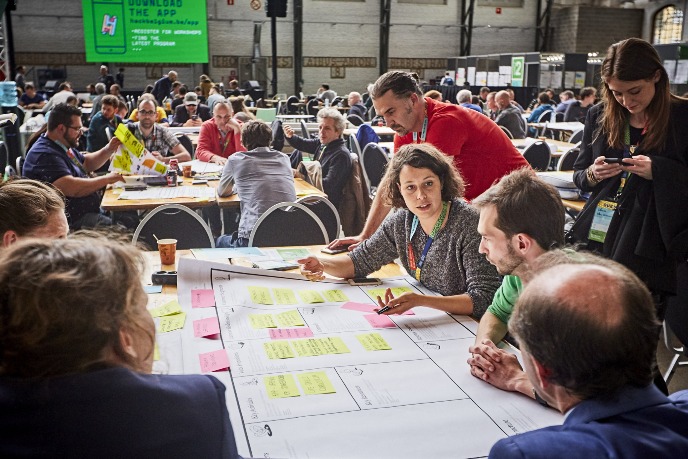Samenwerkingsprojecten
Science LinX werkt natuurlijk niet alleen. Inmiddels is er een uitgebreid netwerk van partners, op zowel plaatselijk als Europees niveau. Lees hieronder meer over onze lopende en afgeronde samenwerkingsprojecten. Wil jij ook met ons samenwerken?
Lopende projecten
Darker Sky
Het Darker Sky project is gericht op het terugdringen van lichtvervuiling in de Noordzeeregio, een belangrijk milieuprobleem met impact op zowel de biodiversiteit als de menselijke gezondheid.
Lichtvervuiling ontstaat door overmatig of slecht gericht kunstlicht, wat de natuurlijke ritmes van dieren verstoort en ecologische verbindingen onderbreekt. Dit internationale samenwerkingsproject brengt 13 partners uit Nederland, Frankrijk, Duitsland en Denemarken samen, waaronder universiteiten, nationale parken, havens en gemeenten. De Rijksuniversiteit Groningen (RUG) speelt een sleutelrol in het Darker Sky project, met expertise op het gebied van astronomie en biologie.
CurioUs?
CurioUs? is een nieuw initiatief van Science LinX, Forum Groningen en de Aletta Jacobs School of Public Health. Met haar activiteiten wil CurioUs? nieuwsgierige noorderlingen enthousiast maken om zelf aan de slag te gaan met wetenschap en techniek en zo hun eigen leefomgeving in kaart te brengen en zelfs te verbeteren. CurioUs? organiseert onder meer meetacties rondom thema's als fijnstof, lichtvervuiling en hittestress. CurioUs? heeft tevens de eerste meet-o-theek van Nederland geopend, een uitleenbibliotheek voor meetinstrumenten.
NL-ECO
Binnen het onderzoeksproject NL-ECO doen 33 organisaties onderzoek naar digitale technologieën van de toekomst. Digitale apparatuur en technologieën, zoals computers, internet en datacentra maken ons leven een stuk efficiënter en bieden mogelijkheden in bijvoorbeeld medische toepassingen.
Echter vreten deze technologieën energie. De hoeveelheid digitale informatie die we verwerken en opslaan en de energiekosten die daarbij horen, groeien exponentieel. Om dat sterk toenemende energiegebruik te drukken, willen de onderzoekers binnen NL-ECO nieuwe materialen, technologieën en wetenschappelijke inzichten voor energie-efficiënte informatietechnologie ontwikkelen.
Haicu
Het HAICu-project gaat over het toegankelijk en inzichtelijk maken van digitaal cultureel erfgoed. Hierin werken AI- en Digital Humanities-onderzoekers samen met erfgoedprofessionals en geïnteresseerde burgers. Het doel is om digitale erfgoedcollecties van verschillende media met elkaar te verbinden en context te geven om verhalen van meerdere kanten te laten zien.
Slim Smullen
Suikers zijn overal, en voor je het weet, heb je er teveel van gegeten... maar het is zo lekker!
Laat je bij SlimSmullen inspireren om minder suiker te eten en slimmer te smullen. Leer van alles over suikers en waarom je er niet zoveel van kan eten als je wil.
Lokaal Leerecosysteem
Science Linx zet zich in voor een lokaal leerecosysteem in de regio Groningen op het gebied van wetenschap, technologie en duurzaamheid. Samen met diverse partners, zoals de scholierenacademie, Openbaar Onderwijs Groningen, Biblionet en Stichting Quadranten, zetten ze zich in voor talentontwikkeling en verankering daarvan via scholen (via leerlijnen en training leerkrachten) en buitenschoolse organisaties (zoals E-labs, de bibliotheek en de Science Truck). Bestaand en nieuw aanbod wordt via een interactieve kaart in de Space Time Layers app zichtbaar gemaakt. Science LinX, Forum Groningen en Aletta Jacobs School of Public Health werken samen aan een ‘meet-o-theek’. Een plek waar je geen boeken, maar onderzoeksinstrumenten kunt lenen.

Afgesloten projecten
Donkerte van de Wadden
Het Programma Donkerte van de Wadden zet zich in voor een groter bewustzijn van het belang van het donker en nodigt mensen uit om de unieke donkerte van de Wadden te beleven. Samen met ondernemers en lokale partners ontwikkelen wij een snoer van donkertebelevingsplekken langs de Waddenkust. Iedereen is welkom is om, geheel kosteloos, de duisternis zelf te ervaren.
Regional STEM learning Network
Science LinX is FSE's expertisecentrum op het gebied van outreach en betrokkenheid van leerlingen, docenten, het maatschappelijk middenveld en het grote publiek.
Irresistible
Binnen het project IRRESISTIBLE zijn lesmodules ontwikkeld voor scheikunde, biologie, natuurkunde en NLT, die gebruikt kunnen worden om actueel onderzoek te introduceren in de klas. Ook wordt in de lesmodules aandacht besteed aan de maatschappelijke implicaties van innovaties.
De modules zijn direct bruikbaar en kunnen vanaf deze site gedownload worden.
Virtual Hackatons
Hoe kunnen we met elkaar een duurzame stad/campus bouwen? Hoe kunnen we een gezond dieet aantrekkelijk maken voor jongvolwassenen? Dit zijn een aantal voorbeelden van complexe vraagstukken die in onze huidige maatschappij spelen en die om een oplossing vragen. Een inclusieve en innovatieve methode om een antwoord te vinden is een hackathon.
Steam it UP
STEAMitUP is een 2-jarig EU-Erasmus+ project dat tot doel heeft bij te dragen aan de vooruitgang van STEAM in het schoolonderwijs en het bewustzijn te vergroten over het belang van de ontwikkeling van 21e-eeuwse vaardigheden. De Rijksuniversiteit Groningen, vertegenwoordigd door Science Linx en het Institute for Science Education and Communication, is een van de partners van STEAMitUP. Het project is een consortium van 6 organisaties uit 6 verschillende Europese landen: VK, Cyprus, Ierland, Griekenland, Spanje en Nederland.
SUSTAIN
Binnen het Erasmus+ project SUSTAIN heeft een internationaal team van wetenschappers, experts in wetenschapseducatie en VO-docenten een driedelige serie ontwikkeld over duurzame Landschappen. De online lesmodules laten leerlingen uit 4 VWO nadenken over maatschappelijke thema’s als behoud van het landschap en het verlies van biodiversiteit. Ook leren leerlingen academische vaardigheden door zelf een onderzoek uit te voeren. In de module worden zowel online- en offline-onderdelen, als onderwijs binnen en buiten het klaslokaal gecombineerd. Module SUSTAIN Biodiversiteit en voedselweb gaat over de weidevogelproblematiek en het verlies van biodiversiteit in de graslanden van melkveehouderijen.
UMARG
UMARG is een nieuw Erasmus+-project dat de educatieve mogelijkheden van Mobile Augmented Reality Games (MARG) onderzoekt bij het ontwikkelen van digitale en maatschappelijke competenties van studenten door te leren over duurzame ontwikkeling. Science LinX en ISEC werken samen in dit project, samen met zeven andere partners uit Roemenië, Griekenland, Cyprus en Nederland.
PERARES
Van 2010 tot 2014 coördineerde de Wetenschapswinkel (dr. Henk Mulder) het PERARES-project; een project van 3 miljoen euro over publieke betrokkenheid bij onderzoek en onderzoeksbetrokkenheid bij de maatschappij, gefinancierd door het 7e Kaderprogramma van de Europese Commissie. Het PERARES-project had als doel om de publieke betrokkenheid bij onderzoek (PER) te versterken door onderzoekers en maatschappelijke organisaties (CSO's) te betrekken bij het formuleren van onderzoeksagenda's en het onderzoeksproces.
| Laatst gewijzigd: | 07 februari 2025 15:10 |

